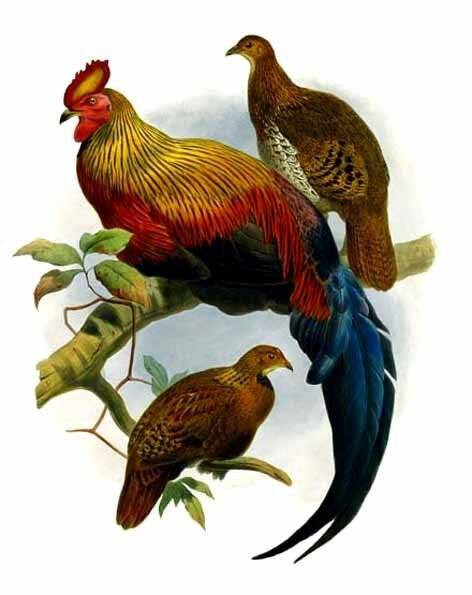Gallus lafayetii
IUCN
LCBasic Information
Scientific classification
- name:Gallus lafayetii
- Scientific Name:Gallus lafayetii,Ceylon Junglefowl
- Outline:Landfowl
- Family:Gallinomorpha P.family Protogallinus
Vital signs
- length:60-72cm
- Weight:790-1140g
- lifetime:No textual research information is available
Feature
The male bird is large, the body feathers are gorgeous and metallic, and the female bird is small and the body color is simple
Distribution and Habitat
It is found in Sri Lanka.
Black-tailed roosters inhabit tropical rainforests, evergreen scrub, secondary forests, coastlines along mountain rainforests, and away from villages, but often invade plantations in search of food.
Appearance
The black-tailed fowl is 60-72 cm long and weighs 790-1140 grams. Showing a strong sexual dimorphism. The male bird has gorgeous plumage; With a corolla on the crown of the head and one or two lobes below the throat; Face and throat are almost completely naked; The neck and waist feathers are long and spear shaped, especially called spear quills. Two wings short rounded; The first primary feather is much shorter than the 10th, the second is between the 8th and 10th, and the 5th and 6th are slightly longest. Most of the tail with 14 or 16 tail feathers, lateral flat; The central pair of tail feathers is elongated, about twice as long as the second pair, and almost 3 times as long as the outermost tail feathers. Its feather-stem is easy to bend, so it appears sickle-shaped and droop; The longest tail coverts are similar, but shorter. The foot is long and strong, the tarsus is longer than the middle toe and the claw, and has a long and curved sharp pitch. The female is smaller; Dull pluma
Details
The black-tailed fowl (Gallus lafayetii) is Ceylon Junglefowl, no subspecies.

The black-tailed pheasant is a species of pheasant, but is most similar in appearance to the grey pheasant and pheasant. The black-tailed pheasant, like the green pheasant, is an island species, evolving alongside predators and competitors on the island. They have a sophisticated strategy for countering predator behavior. It's territorial. They spend most of their time foraging, feeding on plant fruits, seeds, young bamboo, leaves, and various wild petals, as well as termites, termite eggs, worms, and young moths. Male birds live alone, with other females, or in groups with other males. It feeds on the ground but flies well. It lives in trees at night.
The black-tailed fowl is a terrestrial bird, amorous polyandry. During the breeding season, the nest will be built in a high place, the nest is generally chosen next to trees or shrubs, and a shallow nest is laid on the ground, often very high. Old nests of another species are also often selected for reuse. Each litter lays 2-4 eggs, and the female is responsible for incubating and rearing the chicks for an average of 21 days. During this time, the male will be responsible for protecting the nest. Eggs vary in color, usually milky white, yellow or pink, sometimes red, and some have purple or brown spots on the surface. Chicks mainly eat live food, such as insects.
Listed in the International Union for Conservation of Nature Red List of Threatened Species (IUCN) for 2016 ver 3.1 - Not Threatened (LC).
Protect wild animals and eliminate wild meat.
Maintaining ecological balance is everyone's responsibility!








